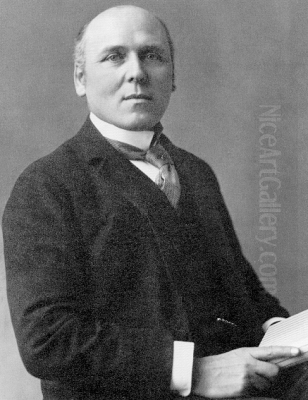
Howard Pyle stands as a monumental figure in American art history, celebrated primarily as an illustrator, but also renowned as a writer and influential educator. His work defined the visual language for generations of readers, particularly in the realms of historical adventure and children's literature. Flourishing during the "Golden Age of American Illustration," Pyle's distinctive style, dedication to historical detail, and profound impact as a mentor cemented his legacy. Born on March 5, 1853, and passing away on November 9, 1911, Pyle's relatively short life was immensely productive, leaving behind a rich body of work and an enduring artistic lineage.
Early Life and Artistic Beginnings
Howard Pyle was born in Wilmington, Delaware, into a family that nurtured his early interests. His father, William Pyle, managed a leather business, while his mother, Margaret Churchman Painter Pyle (referred to as Margaret Campbell Pyle in some sources from the provided text, and noted as coming from a devout Methodist family), possessed a strong literary sensibility that undoubtedly influenced her son. Wilmington, with its Quaker roots and proximity to the historical Brandywine Valley, provided a rich backdrop for the young Pyle's developing imagination.
He received his early education at the Friends School in Wilmington. Even as a child, Pyle displayed a passion for drawing and storytelling. Recognizing his talent, his parents supported his artistic inclinations. At the age of sixteen, he moved to Philadelphia to pursue formal art training. There, he studied for three years under the guidance of F. A. van der Wielen, a Belgian artist. This period was crucial for honing his technical skills, although Pyle would later develop a style distinctly his own.
After his studies in Philadelphia, Pyle initially struggled to find his footing as an artist. He returned to Wilmington for a time, contributing to his father's business. However, his artistic ambitions remained strong. A pivotal moment came in 1876 when Scribner's Monthly magazine published one of his illustrations. This success encouraged him to move to New York City, the heart of the publishing world at the time, to pursue a career as a professional illustrator.
Establishing a Career: Illustration and Writing
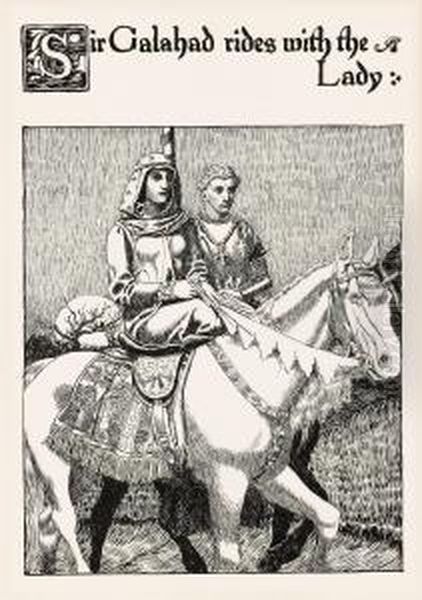
In New York, Pyle worked diligently to establish himself, contributing illustrations to prominent publications such as Harper's Weekly, St. Nicholas Magazine, and Collier's Weekly. The late 19th century was a boom time for illustrated periodicals, providing ample opportunities for talented artists. Pyle quickly gained recognition for his dynamic compositions and his ability to capture dramatic moments.
A unique aspect of Pyle's career was his dual role as both writer and illustrator. Unlike many illustrators who visualized the texts of others, Pyle often created both the stories and the pictures. This integration allowed for a seamless blend of narrative and visual storytelling. His first major success in this vein was The Merry Adventures of Robin Hood of Great Renown in Nottinghamshire, published in 1883.
Pyle meticulously researched and rewrote the traditional Robin Hood ballads, crafting a cohesive narrative suitable for younger readers while retaining the adventurous spirit of the original tales. His illustrations for the book, often inspired by the woodcuts of the German Renaissance master Albrecht Dürer, were rendered in a distinctive pen-and-ink style that evoked a medieval feel. The book was an immediate success and remains a classic of children's literature, largely defining the popular image of Robin Hood and his band.
Following Robin Hood, Pyle continued to write and illustrate numerous books, often drawing on historical or fantastical themes. Otto of the Silver Hand (1888), a poignant tale set in medieval Germany, showcased his ability to convey deep emotion and historical atmosphere. His works frequently explored themes of chivalry, adventure, and morality, presented with a romantic sensibility.
Pyle's artistic style evolved throughout his career. While influenced by artists like Dürer, his work was characterized by strong, energetic lines, a keen sense of drama, and meticulous attention to historical detail. He was particularly adept at depicting action and creating immersive settings, whether it be the deck of a pirate ship or the halls of Camelot. His commitment to accuracy in costume and setting lent authenticity to his historical illustrations, particularly those depicting American colonial life.
The Brandywine School and Pyle's Teaching Philosophy
After achieving significant success, Pyle returned to Wilmington in 1880, establishing his home and studio there. His influence extended beyond his own creative output; he became a dedicated and transformative teacher. In 1894, he began teaching illustration at the Drexel Institute of Art, Science and Industry (now Drexel University) in Philadelphia. His classes quickly became renowned, attracting talented students eager to learn from the master.
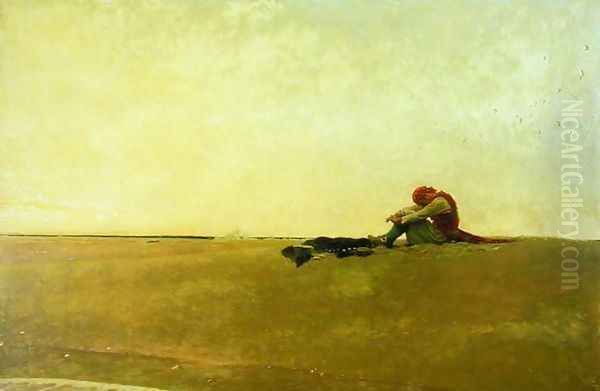
Pyle's teaching methods were unconventional for the time. He emphasized imagination, emotional connection, and personal experience over rote technical exercises. He famously encouraged his students to "throw your heart into the picture and then jump in after it," urging them to fully immerse themselves in the scenes they were depicting. He believed that effective illustration required not just skill, but also a deep understanding of the subject matter and the ability to convey genuine feeling.
In 1900, Pyle left Drexel to establish his own school, the Howard Pyle School of Art, in Wilmington. He offered free tuition to a select group of promising students, fostering a close-knit, intensive learning environment. He also conducted summer classes in the nearby town of Chadds Ford, Pennsylvania, immersing his students in the historical landscape of the Brandywine Valley. This focus on the region and a shared artistic philosophy led to the emergence of the "Brandywine School" of illustration.
Pyle's roster of students reads like a who's who of early 20th-century American illustration. Among his most famous pupils were N.C. Wyeth, known for his dramatic illustrations for classic novels; Maxfield Parrish, celebrated for his luminous colors and fantastical imagery (though more influenced by Pyle than a direct, long-term student); Frank Schoonover, who captured the spirit of the American wilderness; Violet Oakley, a renowned muralist and stained-glass artist; Harvey Dunn, known for his powerful depictions of prairie life and World War I; and Stanley Arthurs, who specialized in historical subjects.
Other notable students included Jessie Willcox Smith, Elizabeth Shippen Green (along with Oakley, known as the Red Rose Girls), George Harding, and Peter Hurd. Pyle also mentored female artists like Ida Dougherty (referred to as Ida Douglas Pitz in the source text) and Elenore Plaisted Abbott (referred to as Elenore Ellerbe), helping them forge successful careers in a male-dominated field. The influence extended further, with students like Dean Cornwell carrying the tradition forward and mentoring artists like Ralph Barksdale. Pyle's emphasis on historical accuracy, dynamic composition, and storytelling through art became hallmarks of the Brandywine tradition.
Iconic Works and Artistic Style
Howard Pyle's body of work is vast and varied, encompassing medieval legends, pirate adventures, American history, and fairy tales. Beyond The Merry Adventures of Robin Hood and Otto of the Silver Hand, several other works stand out as representative of his talent and interests.
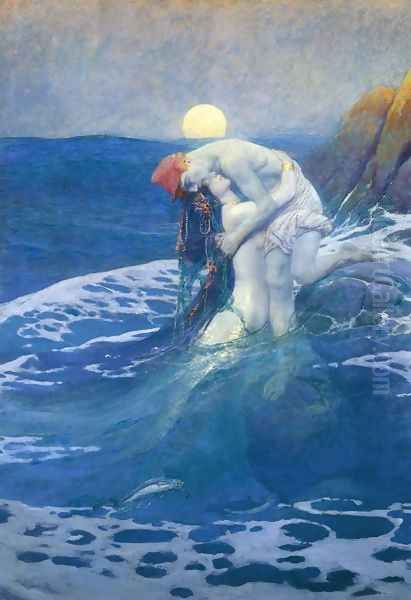
His fascination with King Arthur resulted in a four-volume series: The Story of King Arthur and His Knights (1903), The Story of the Champions of the Round Table (1905), The Story of Sir Launcelot and His Companions (1907), and The Story of the Grail and the Passing of Arthur (1910). Again, Pyle both retold the legends and provided stunning illustrations, creating a definitive version for many American readers. His depictions of knights, castles, and mystical encounters are iconic.
Pyle is also credited with shaping the modern image of pirates. His stories and illustrations, particularly in works like Howard Pyle's Book of Pirates (compiled posthumously in 1921), moved away from earlier, more cartoonish depictions towards a more romanticized but visually detailed portrayal. He established much of the popular pirate iconography, including specific styles of dress and dramatic seafaring scenes. His painting Marooned is a powerful example of his pirate imagery.
He also tackled American historical subjects with great passion. His oil painting Grandmother's Story of Bunker Hill Battle (1898, though dated 1901 in the source text's museum reference) and illustrations for works like Oliver Wendell Holmes Sr.'s poem of the same name, or Paul Leicester Ford's novel Janice Meredith: A Story of the Revolution, demonstrate his commitment to bringing American history to life. He painted historical murals as well, though his ambition to master this form fully would lead him abroad later in life.
A more allegorical work, Why Search for the Living Among the Dead (1905), was reportedly inspired by a sculpture by Augustus Saint-Gaudens, showcasing Pyle's engagement with the broader art world. His style, whether in pen-and-ink or full color oils, consistently emphasized strong narrative, dynamic composition, and emotional impact. While some contemporaries found his style occasionally "rough" or "vulgar," its energy and directness proved immensely popular and influential.
Pyle and His Contemporaries
Howard Pyle operated within a vibrant artistic landscape. He was an active participant in the art communities of Philadelphia and New York. He was associated with the Art Students League in New York early in his career and later became a member of the prestigious Society of Illustrators and the Salmagundi Club. He also created work for organizations like the Bibliophile Society of Boston.
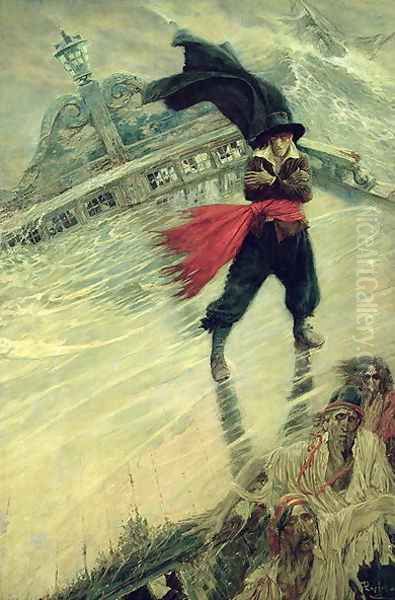
His success brought him into contact with other leading artists of the day. The provided source material notes he socialized with prominent figures such as the painter and influential teacher William Merritt Chase, the celebrated painter of American life and seascapes Winslow Homer, and the preeminent sculptor Augustus Saint-Gaudens. However, the specific details of his interactions with Chase and Homer are not well-documented in the available records referenced by the source text. His connection to Saint-Gaudens is suggested by the inspiration for his painting Why Search for the Living Among the Dead.
Pyle's work can be contextualized alongside other major illustrators and artists of the period. Edwin Austin Abbey, another American artist known for his historical illustrations and murals (particularly Shakespearean and Arthurian themes), shared Pyle's interest in historical detail, though often with a more delicate style. Frederic Remington, famous for his depictions of the American West, focused on a different aspect of American identity but shared Pyle's commitment to dynamic storytelling and authenticity within his chosen milieu. Pyle's dedication to illustration as a serious art form helped elevate its status during a period when the lines between fine art and illustration were often rigidly drawn.
Later Years and Legacy
In 1910, seeking to further his skills in mural painting, a medium he had explored but wished to master, Howard Pyle traveled to Italy with his family. He intended to study the works of the Old Masters in Florence. Tragically, his time there was cut short. He fell ill and died in Florence on November 9, 1911, at the age of 58. The cause of death was recorded as Bright's disease, a kidney ailment.
His death was a significant loss to the American art world. Pyle left behind an indelible legacy. He had not only created a vast and beloved body of work but had also fundamentally shaped the course of American illustration through his teaching. The Brandywine School tradition, carried on by his students like N.C. Wyeth and their subsequent pupils, continued to influence illustration and regional art for decades.
Pyle's personal life also informed his work. The death of his young son, Sellers, in 1889 was a profound blow that is believed to have deepened the emotional resonance found in some of his later works, such as Otto of the Silver Hand. His dedication to his family, his craft, and his students defined his character.
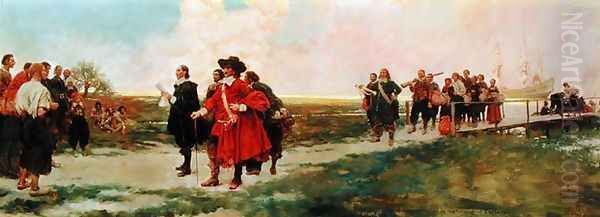
His influence extends beyond the art world. His retellings of classic stories like Robin Hood and King Arthur introduced these tales to countless children and remain popular versions today. His visual interpretations of pirates, knights, and colonial figures have permeated popular culture. He elevated illustration from mere decoration to a powerful form of storytelling and historical interpretation.
Museum Collections and Enduring Presence
Howard Pyle's importance is reflected in the preservation of his work in major museum collections. The most significant repository is the Delaware Art Museum in his hometown of Wilmington. Founded in 1912, partly as a memorial to Pyle by the Wilmington Society of Fine Arts (potentially related to the "Wilmington Society of Arts and Crafts" mentioned in the source text), the museum holds the largest collection of Pyle's work anywhere, numbering over 100 pieces, including paintings, drawings, and prints. Much of this core collection was acquired or donated by Pyle's widow, Anne Poole Pyle. The museum also holds extensive collections of works by his students and other figures associated with the Brandywine School, making it a vital center for the study of American illustration.
Works by Howard Pyle are also held and have been exhibited by other institutions. The Brandywine River Museum of Art in Chadds Ford, Pennsylvania, located in the heart of the region so central to his teaching, holds important works, including paintings like Viewing The Battle of Bunker Hill (dated 1901 in source text reference) and illustrations for Janice Meredith. It also houses archival materials, including manuscripts and books, thanks in part to donations like that of Paul Preston Davis.
The Norman Rockwell Museum in Stockbridge, Massachusetts, dedicated to the art of illustration, has also featured Pyle's work prominently. It hosted a major exhibition titled "Howard Pyle: American Master Rediscovered," showcasing numerous original works. The museum recognizes Pyle's foundational role in the field that Norman Rockwell himself would later dominate.
Howard Pyle's enduring presence is felt not only in museums but also in the continued publication of his books and the lasting influence of his visual style. As a master storyteller in both words and pictures, and as a dedicated mentor who launched the careers of many other significant artists, Howard Pyle rightfully holds the title of the "Father of American Illustration." His work continues to inspire and transport readers and viewers into worlds of history, adventure, and imagination.